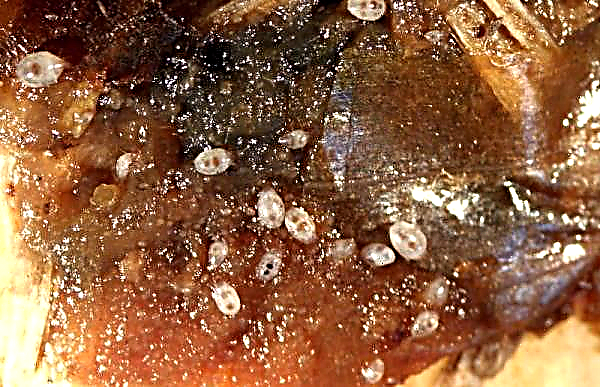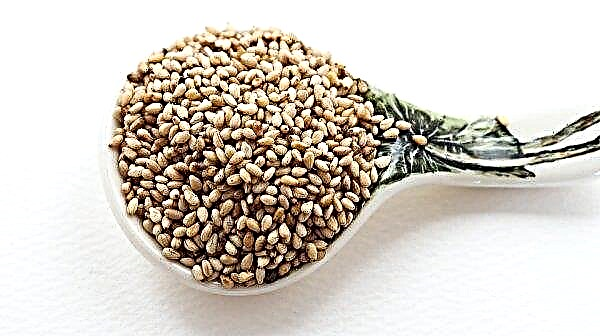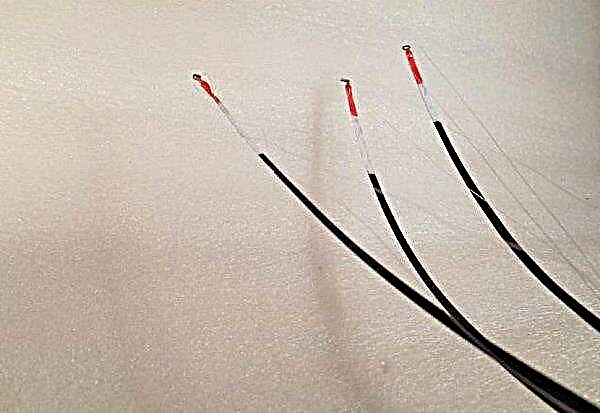The antibacterial and regenerative properties of fir have been noticed for a long time. Each part of this tree is endowed with healing power, many pharmaceutical preparations are made from it and recipes of folk remedies based on fir raw materials are stored. The features of their use, benefits and potential harmful effects will be discussed in the article.
Composition of fir
In pharmaceuticals, the plant material of Siberian and white fir is widely used, because these species are a storehouse of useful trace elements, vitamins, essential oils and resins, from roots to needles.
Did you know? During World War II, Professor A. V. Vishnevsky introduced into balsam from resin of Siberian fir into scientific medicine as an effective antiseptic and saved many soldiers from purulent wounds, boils and abscesses leading to gangrene.
Health-relevant components are extracted from:
- tree root system. From here you can extract up to 8% of essential oils, up to 80% of camphor, useful organic acids, fragrant bisabolene;
- woodwhere 4% of essential oils and 85% of ready camphor are located;
- bark with a high level of tannins — 13%, fir balsam — 15%;
- gum, which contains 70% resin, 30% essential oil and is used for the production of turpentine, industrial resins, alcohol;
- needles and young growth, where 3.5% is essential oil, 60% - organic acids of the terpenes class. Among the therapeutic elements contained in the green mass, ascorbic acid, carotene, proteins, carbohydrates, volatile, flavonoids and trace elements such as copper, iron, cobalt, manganese and zinc are isolated. The antioxidant properties of vitamin C contribute to the rapid removal of toxic substances from the body, increase the elasticity and strength of the circulatory system, and protect against infections. The presence of β-carotene, which can be converted into vitamin A, improves vision, improves immunity;
- seeds of ripe cones more than a third consist of fatty oils, contain vitamin E, oleic, lauric and carminic acid - the most important of the fatty acids that regulate metabolism; unique composition of elements in the finished fir oil. Without such components as borne acetate, borneol, camphene, dipentene, bisabolene, santenum present in it, neither perfumery production, nor pharmacology, nor the chemical industry can do.
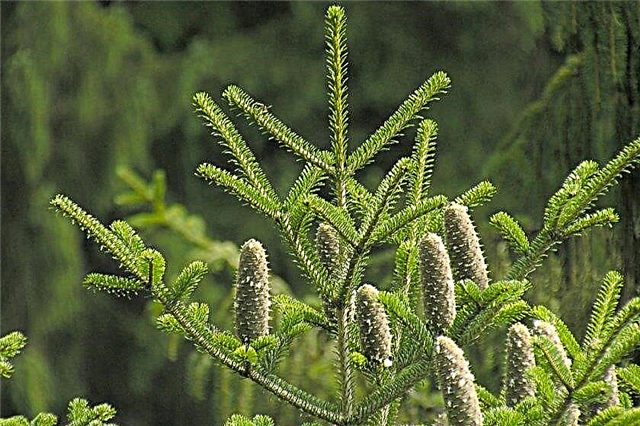
What is useful for fir
Official medicine includes its components in the treatment of many serious diseases. Bark, gum, branches, cones and needles are used for medical purposes to create camphor, turpentine, fees. High levels of nutrients in plant tissue and the effectiveness of the application make fir an indispensable tool with tonic, expectorant, anti-inflammatory, diuretic, wound healing effect.
Important! An overdose of fir oil in the aroma lamp can cause migraines and an allergic attack. For a room measuring 10 m² enough 4 drops!
On its basis, neuroprotectors, antiseptics, disinfectants, fortifying agents have been developed.
- The benefits of this tree are great:
- from wood raw materials make paper and soundboards for resonant musical instruments.
- in medicine wood is used for the manufacture of tar and activated carbon;
- at home use oil to repel insects, disinfect water and air, prevent the spread of infection, including staphylococcal, prevent mold in the premises;
- herbal remedies effective in removing edema, treating non-healing wounds and trophic ulcers, in postoperative rehabilitation, for treating diseases of the digestive tract, stimulating the cardiovascular system, eliminating hypovitaminosis, and preventing tumors;
- with inflammation and pain in joints recommend steam heating and baths with fir needles. Such baths relieve neuralgia, relieve hysteria, manifestations of depression, improve the epidermis in skin diseases;
- fir oil used for massage for arthritis, radiculitis, rheumatism, osteochondrosis, myositis and arthrosis. Add it to shampoos that normalize the sebaceous glands, and ointments that eliminate acne;
- essential oil from fir It is famous for its antiviral, bactericidal, antifungal effects, it effectively cleans the air of dust, pathogens, helps with insomnia, weakness, fatigue. Phytoncides will eliminate the inflammatory processes of the upper respiratory tract in case of viral infections, flu, tonsillitis, pneumonia, tuberculosis, exacerbations of tonsillitis, and immunodeficiency states. The aroma of fir eliminates asthmatic bronchospasm and catarrh of the upper respiratory tract, can relieve headaches;
- infusion of buds and needles on the water treat scurvy, it is used as a diuretic and analgesic for cystitis and prostatitis;
- of green needles make a powerful immunostimulant, known as "Florentine water";
- fir resin can be purchased at the pharmacy in the form of a solution of 5%, 25%, 30%. It is used externally for the treatment of wounds, cuts, burns, boils and inside with varicose veins, colds, gastritis. This is the main component of turpentine and fir balsam. In addition to medicine, resin is used in the optical industry and in perfume compositions;
- tinctures and decoctions on dry bark they eliminate migraine, relieve high pressure. Its astringent properties can help with toothache, gum disease;
- fir cones useful for rheumatic pains in the form of decoctions and baths for the legs;
- young april buds with a lot of antioxidants tend to improve the skin and condition of the hair. Their high content of vitamins C and E is able to expel colds, bronchitis and increase weakened immunity.

Collection and harvesting of raw materials
Pure fir plantations cannot be found now, these trees can be found in the second tier in aspen forests, mixed with cedar forests and spruce forests, but they do not grow near pine trees. The range of wild growth of trees is limited to the taiga of Siberia for Siberian fir and the Carpathian forests for white fir. The pharmacological features of the procurement of raw materials in therapeutic species are the same.
Important! Fir oil is not soluble in water! To get Florentine water, beat 4-5 drops and 1 liter of water with a mixer.
The collection can be carried out during the year with different goals for the further use of raw materials, because the concentration of nutrients and the quality of the oil varies from season to season. The greatest amount of essential substances accumulates needles at the beginning of the growing season in the spring and with the end of this period in the fall. The content of the medicinal element of bornyl acetate reaches a peak by the end of autumn, so it is advised to prepare conifers twice.
Experienced pharmacologists recommend focusing on the following dates for the collection of material:
- bark it is worth collecting in early spring, when sap flow begins, and the maximum concentration of nutrients is reached;
- sap it is available during the warm season, but when collecting it, keep in mind that the notch of the trunk must be made at + 16 ° C and above;
- the kidneys it is advisable to cut off immediately after the appearance, but before dissolution, which will occur in late March or early April, depending on climatic conditions;
- pollen cut off in the early spring, during the March pollination;
- lapnik good harvest from May to early June;
- needles you can cut twice - at the end of July you can get a high yield of oil. From October to February, especially on frosty days, the content of ascorbic acid rises, the needles are saturated with active substances;
- ripe cones tear off before the time of natural shedding in September-October.
 Gum, kidneys and needles are used fresh for the preparation of infusions and concentrates with a high content of vitamins, which should be immediately used. It is permissible to dry needles. The bark is crushed and dried with a thin layer on paper or a clean cloth in the conditions of shadow, heat and absolute dryness, constantly mixing. Dried raw materials are stored longer and will bring more benefits.
Gum, kidneys and needles are used fresh for the preparation of infusions and concentrates with a high content of vitamins, which should be immediately used. It is permissible to dry needles. The bark is crushed and dried with a thin layer on paper or a clean cloth in the conditions of shadow, heat and absolute dryness, constantly mixing. Dried raw materials are stored longer and will bring more benefits.
Place the collected material tightly in hermetically sealed metal or glass jars. They are suitable for use for 2 years. Fir extract is obtained from young spring needles in an industrial environment. It is a viscous substance of dark brown color and a bitter taste. It is characterized by a high content of resins, phytoncides, tocopherols, tannins. It is impossible to prepare it at home, but it is easy to purchase at a pharmacy.
For internal use, it is bred with water in an amount of 0.5 tsp. for 1 glass of water, and for taking a coniferous bath, 150 g of concentrate will be enough. Fir oil is obtained by steam distillation. Essential substances and fats float, separating from water, after which they are collected. At home, without special equipment, this is difficult to do, so it is better to purchase high-quality fir oil.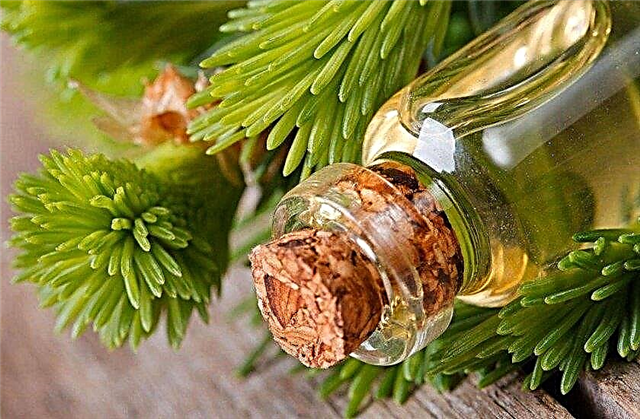
Application in traditional medicine
Since ancient times, people knew about the special properties of fir. Its branches, entwined with ivy, were revered in Athens as a sign of the goddess of magic Hekate. Americans still hang ritual, and now Christmas fir wreaths on the front doors. Even 5 thousand years ago, the Sumerians made compresses from crushed dried needles. It is believed that the "balsam from Gilead" mentioned in the Bible is nothing but the resin of balsam fir growing in Canada.
It is known that North American Indians used this resin as a protective coating that promotes the healing of deep wounds and cuts. Modern adherents of natural products call this sticky substance from gum a panacea for any disease at any stage. Subsequently, the production of "Canadian Balsam" was put on stream even as a varnish coating and glue for optical lenses.
Important! Self-medication with galenic fir preparations is strictly prohibited in the presence of any allergic reactions! Consult a physician about the permissibility of their use.
In ancient Russia, oil from Siberian fir was used to treat nervous disorders, and with the needles of young branches at the end of winter, Siberians took therapeutic baths with a general strengthening effect. Baths and brooms from spruce branches flavored with fir oil are still considered an excellent way to relieve pain and inflammation, cleanse the respiratory system, and prevent seasonal viral infection, and also give energy and a good mood. For several millennia, the Chinese have been using resin for getting rid of headaches and toothaches. It is still used without processing in its natural form as a hemostatic, disinfecting, analgesic. Now it is supplemented with toothpaste and elixirs.
For several millennia, the Chinese have been using resin for getting rid of headaches and toothaches. It is still used without processing in its natural form as a hemostatic, disinfecting, analgesic. Now it is supplemented with toothpaste and elixirs.
The great-grandfather’s methods continue to work smoothly: there is no better way to cure scurvy than an aqueous solution of needles, and fir steam from boiled cones is guaranteed to anesthetize and warm sore feet. Traditional healers widely use oil for inhalation, needles, cones and bark in the form of extracts, infusions, alcohol lotions, decoctions for influenza, bronchitis, tuberculosis, rheumatism, flu and many ailments.
With a cold, cough and runny nose
The ability of coniferous phytoncides to defeat viral infections helps to heal colds, tonsillitis, flu, tonsillitis, bronchitis, tracheitis and strengthen the body's immune barrier with fir. As an addition to serious therapy, preparations with an expectorant effect on its basis cleanse the upper and lower respiratory tract, contributing to the discharge of sputum in pneumonia and tuberculosis. Fir twig broom works as an inhaler for problems with the respiratory system. It is enough to pour boiling water over the branches, as the steam will release the antibacterial essential oils that the lungs will be saturated with.
Fir twig broom works as an inhaler for problems with the respiratory system. It is enough to pour boiling water over the branches, as the steam will release the antibacterial essential oils that the lungs will be saturated with.
Fir resin is also used to treat colds, for this:
- Dissolve 50 g of the resin in the same amount of warm boiled water until the consistency of the paste.
- Add to the resulting paste 1 tbsp. sugar, then form pea-shaped sweets.
- Put such a pea on your cheek after each meal for resorption.
With the inflammatory process of the throat and oral cavity, a decoction of fir will help:
- Pour 250 g of fresh needles 1 liter of boiling water.
- Boil the broth for 7-10 minutes, then strain.
- Gargle them throat 2-3 times a day.
Cold infections can be defeated with a small amount of essential oil, which has an antiseptic effect due to the high content of cineol, pinene, borneol. It will narrow blood vessels, conquer nasal congestion and runny nose. The natural composition of the oil, unlike aggressive pharmacy products, acts without burning on the mucosa.
Important! Even a small dose of fir oil consumed on an empty stomach will cause indigestion!
To combat the symptoms of a cold:
- for sore throat, add 2 drops of fir oil, 1 tbsp. honey, 1 teaspoon of salt in a glass of warm water, drink before bedtime;
- strong nightly attacks of coughing can be stopped by applying 2-3 drops of oil under the root of the tongue with a pipette;
- for inhalation with bronchitis, pour 1 liter of boiling water in an enamel bowl, drop 2–4 drops of essential oil into it, cover with a head cover and inhale deeply for 5 minutes;
- with tonsillitis, tonsils are lubricated with fir oil to eliminate pain;
- 5-time rubbing of the upper back, chest, feet will help with bronchitis and pneumonia, be sure to wrap the patient with a blanket afterwards, strengthen the warmth with a woolen scarf and give warm tea with a diaphoretic effect;
- with a runny nose and sore throat 2-3 times a day, lubricate the wings of the nose and nose, or drip 1 drop into each nostril.

In oncology
Recently, scientists have discovered the anti-cancer properties of fir extract, which can replace radiation and chemotherapy without serious side effects. As it turned out, the terpenoids contained in the resin of the tree positively affect the body, activate the defense against the aging process and trigger the self-destruction gene of cells altered by cancer. The development of a fundamentally new, full-fledged agent for cancer patients based on fir extract is underway.
Its production is still very expensive, but geneticists do not intend to abandon attempts to study the action of terpenoids in existing, registered, inexpensive drugs, such as Abisil. Traditional medicine recommends an immunostimulant from fir honey as an aid in the fight against cancer cells.
Instead of flower pollen, in the process of its production, a pad is used, that is, the isolation of insects that feed on fir juice. Such "honey" is darker than usual, with a pronounced aroma of resins, its taste is less sweet. Moreover, the amount of minerals, vitamins and antioxidants is many times greater than this composition in the most useful types of honey. You can buy it in specialized stores in the Mediterranean countries. If you cannot get honeydew honey, try to prepare a replacement for it.
 Despite the inferiority of such an analogue, fir kidney syrup also has qualities that increase the protection of the immune system:
Despite the inferiority of such an analogue, fir kidney syrup also has qualities that increase the protection of the immune system:
- Combine 1 kg of raw materials and 1 liter of water in containers.
- Digest the kidneys for 15 minutes, then leave to infuse for 1 day.
- Mix 2 kg of granulated sugar with a decoction.
- Boil the mixture, stirring, over low heat for 2 hours.
- Take syrup 2-3 times a day for 1 tbsp. before eating.
During pregnancy
The process of bearing a baby can be complicated by unpredictable reactions to odors, in addition to the already proven toxicity of fir for embryos in early pregnancy. Therefore, doctors categorically do not recommend the internal use of products from fir raw materials so as not to harm the fetus. Do not get carried away and aromatherapy - coniferous smell can cause nausea and vomiting. For the same reason, you can not use fir oil as a remedy for a cold.
Only after the permission of the doctor who is conducting your pregnancy, in the absence of other contraindications in the later stages, is it permissible to use a small amount of oil as an antiseptic and a wound healing agent when cut when there are no medications nearby. In case of toothache, if there is no medical prohibition, put a cotton swab with a few drops of oil on a sick tooth before dental procedures - this will replace anesthesia. It is believed that warm baths with the addition of 3 drops of oil will help to avoid stretch marks, however this is a very individual advice, requiring clarification from your gynecologist.
In case of toothache, if there is no medical prohibition, put a cotton swab with a few drops of oil on a sick tooth before dental procedures - this will replace anesthesia. It is believed that warm baths with the addition of 3 drops of oil will help to avoid stretch marks, however this is a very individual advice, requiring clarification from your gynecologist.
With adenoids
Children suffering from adenoid vegetation are very sensitive to rinsing the nose. Inhalations will become a pleasant and effective addition, they will eliminate swelling and facilitate nasal breathing.
Steam procedures with essential oils or fir decoction show good results:
- twice a day, carry out wet inhalation for 5-10 minutes, placing 0.5 hours of fir infusion in a plastic inhaler;
- mix 2-3 drops of oil with 0.5 l of mineral water and pour the solution into the nebulizer;
- dry inhalation will help diversify the procedure - just 1 drop of oil on a handkerchief, through which you need to breathe, is enough;
- a pleasant solution is to add a couple of drops of oil to sea salt or foam when taking baths.
Prescriptions and Dosages
Despite the seeming harmlessness of galenical drugs, it is not for nothing that they are sold exclusively in pharmacies. Resinous substances tend to accumulate in the body. Make sure that the daily amount of oil does not exceed 5-10 drops of fir oil inside and 8-10 g for external use. Exceeding the concentration of any drug can turn the benefit to harm. Strictly follow the instructions for the medicine for the quantity, features and time of use. It is not necessary to arrange a complex chemical laboratory at home if the right product, which has passed quality control, is available in any pharmacy. Observe the exact dosage, especially when taken orally. A different concentration of identical components gives in some cases a diametrically opposite effect.
It is not necessary to arrange a complex chemical laboratory at home if the right product, which has passed quality control, is available in any pharmacy. Observe the exact dosage, especially when taken orally. A different concentration of identical components gives in some cases a diametrically opposite effect.
A harmless, at first glance, decoction in case of uncontrolled use will cause a sharp jump in pressure, and coniferous tea can disrupt the heart rate. Taking alcohol tinctures without a sense of proportion or with health restrictions will have negative consequences due to the high concentration of alcohol. Be sure to consult with a therapist regarding the appropriateness of such treatment.
Did you know? The ancient Greeks believed that the Trojan horse was built from cephaline fir wood.
Decoction
Coniferous broth is useful for diseases of the cardiovascular system, anemia, vitamin deficiency, colds, flu, tonsillitis. Fir needles have a beneficial effect on blood purification, vessel elasticity, helps to eliminate toxins and radionuclides, and stimulates performance.
Ingredients:
- fir bark - 2.5 tbsp. l .;
- fir needles - 2.5 tbsp. l .;
- boiling water - 0.5 l.
Step-by-step cooking instructions:
- Place the bark and needles in a deep bowl, add boiling water, immediately cover with a tight lid. You can use a thermos.
- Leave the broth for the night, let it insist until it cools completely, in the morning it must be filtered.
- Take a dose of 50 ml daily for 2 weeks, 4 times a day.
 There is another way to make a decoction on fire.
There is another way to make a decoction on fire.
Ingredients:
- needles of fir - 2 tbsp. l .;
- boiling water - 0.5 l.
Step-by-step cooking instructions:
- Rinse with needles, put it in a pan.
- Add boiling water, put on a slow fire.
- Boil the broth for 20 minutes, then 30 minutes. let it brew.
- Filter - the broth is ready for use.
- Drink for 2 weeks, but not more than 1 cup per day in the total volume, try to divide the broth into 3 servings.
Needle Tea
A medicinal collection containing fermented raw materials of Ivan-tea and dried fir needles is useful for eliminating neurosis, edema and gastric diseases. Its use for a long time (2-3 weeks) will improve the state of the nervous system, drive away insomnia, and eliminate headaches. It is useful for tonsillitis, rhinitis, sinusitis, exacerbation of psoriasis, joint pain.
Ingredients:
- dry Ivan tea: 1 tsp;
- dry fir needles: 1 tsp;
- hot water: 0.25 l.
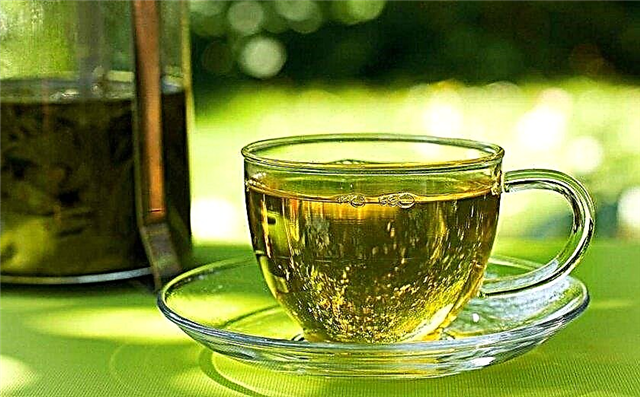 Step-by-step cooking instructions:
Step-by-step cooking instructions:
- Mix the ingredients in equal volumes, pour into a heated teapot.
- Pour dry collection with hot, but not boiling water (up to + 80 ° С).
- Leave to infuse for 10 minutes.
- To improve the taste and additional benefits, add honey to the drink if desired.
- Drink no more than three times a week and no more than 1 cup per day.
Important! Fir needles spoil tooth enamel, use a straw for drinks based on it, and then thoroughly rinse your mouth with warm water.
Bark infusion
To get rid of headaches and noise in the head, restore the central nervous system and heart, traditional medicine recommends taking an infusion from the bark. It is able to lower blood pressure, calm, increase immunity or have a tonic effect on a person, depending on the preparation option. The tonic and cleansing effect will bring the following cooking option.
Ingredients:
- chopped fir bark - 250 g;
- water - 500 ml.
Step-by-step cooking instructions:
- Put the bark in a bowl and fill it with 1 cup of water.
- Put on fire, bring the infusion to a boil.
- Boil for 10 minutes, then leave to infuse for 1 hour.
- Strain the infusion, bring it to its original volume, diluting it with boiled water.
- Take 100 g three times a day half an hour before meals. After every 15 days of admission, a week break is required.
- If necessary, repeat the course of treatment after a month.
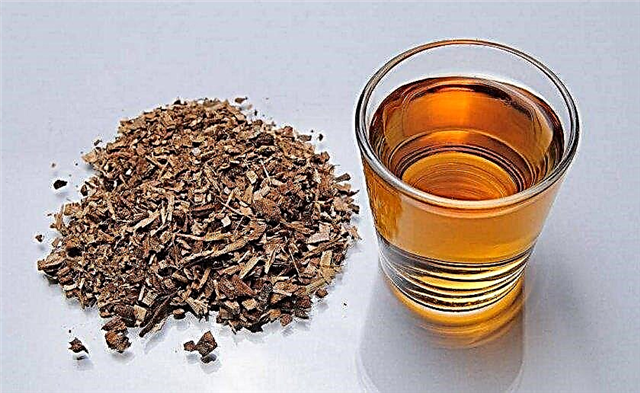 To reduce blood pressure, use the following recipe with a reduced concentration of raw materials.
To reduce blood pressure, use the following recipe with a reduced concentration of raw materials.
Ingredients:
- chopped fir bark - 300 g;
- water - 2 l.
Step-by-step cooking instructions:
- Place the bark in a container and pour 2 liters of water.
- Put on fire, bring the infusion to a boil.
- Boil for 20 minutes. over low heat, then filter.
- Store the cooled infusion in a glass, sealed container in the refrigerator.
- Take 100 g up to three times a day. The course of admission is 1-2 months. After every 10 days of admission, a ten-day break is required.
Tincture of cones on vodka
Coniferous tinctures on vodka in moderate doses are indicated for oncology, neurasthenia, depressive states, impotence, polyarthritis, and diabetes mellitus. Immature fir cones will help relieve inflammation and pain with rheumatism, radiculitis, osteochondrosis and arthritis.
Did you know? Fir blooms when a tree reaches the age of 60 or 70 years.
Tincture will help to normalize the condition of the bladder and intestines, can be used in compresses and rubbing to warm and anesthetize for pain in the joints. It’s easy to cook.
Ingredients:
- green fir cones - 5 pcs.;
- vodka - 0.5 l.
 Step-by-step cooking instructions:
Step-by-step cooking instructions:
- Grind the fruit with a knife.
- Pour them with vodka and insist 2 weeks in a dark, warm room.
- Stir the ingredients every 3 days by shaking the bowl.
- Strain and transfer the tincture into another dish.
- As a remedy, take 1 tbsp. 3 times a day on an empty stomach before meals.
- For prevention, take 1 hour after the first meal 1 time per day.
Did you know? The peoples of Primorye revered fir as a sacred tree and forbade its felling, although they built houses from log cabins.
Contraindications and possible harm
- Doctors prohibit the use of fir-based preparations in a number of the following cases:
- in the presence of an allergy to needles;
- with individual intolerance to fir;
- during pregnancy and lactation;
- children under 1 year old;
- with a tendency to epilepsy and seizures;
- with pain in the heart;
- in the acute phase of joint injuries;
- with the appearance of tumors in the organs of the peripheral nervous system;
- with acute liver damage and kidney pathologies;
- with gastritis and stomach ulcer;
- with increased acidity of gastric juice;
- simultaneously with the intake of alcohol and with the withdrawal from alcohol intoxication.

- There are precautions that are observed when using drugs from this plant:
- do not take the drug on an empty stomach, otherwise you can not avoid heartburn and nausea;
- external use of fir oil in undiluted form after a sensation of frosty cold can cause irritation of the skin and mucous membranes;
- aroma of fir can lead to bronchial spasms - conduct a two-minute aerosol test, inhaling a drop of oil from a cotton pad;
- excess dosage can lead to chills, increased sweating, abdominal pain, nausea, intolerance to fir needles in the future; store the product at a temperature of + 12 ... + 25 ° C away from children.
Official medicine has long confirmed the powerful effect of using any part of this useful tree. But the healing effect of such funds will improve the state of health only with their competent use.



